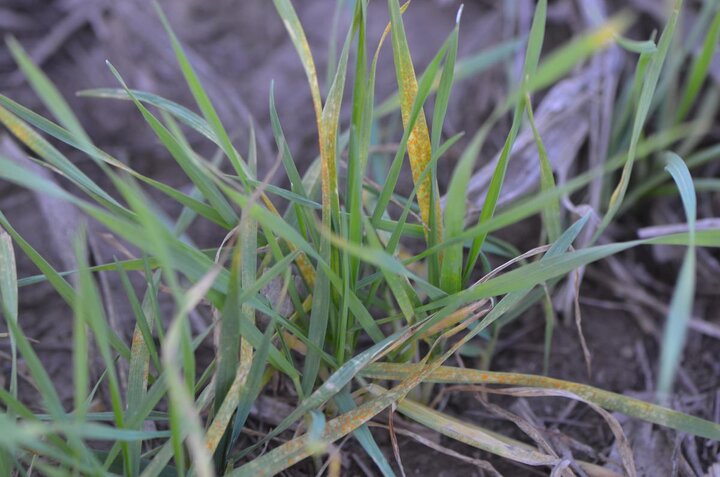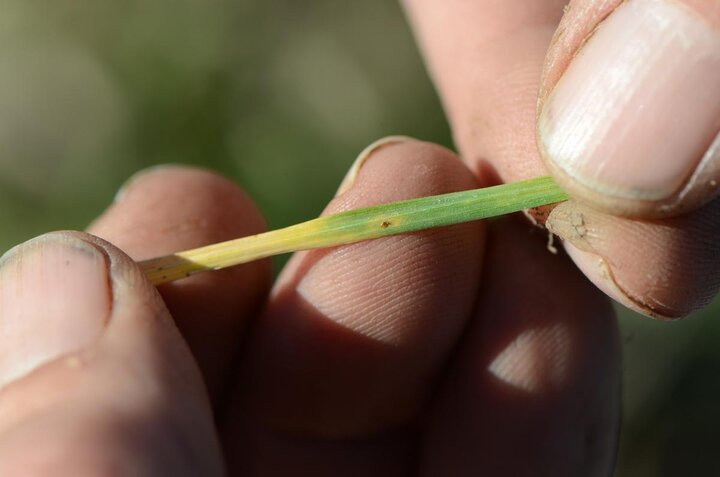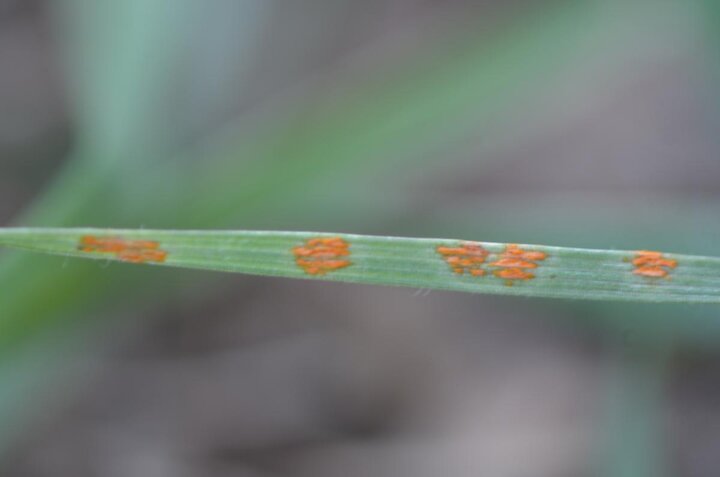

Based on reports received in early November, two growers’ fields in Webster County in south central Nebraska were surveyed for rust diseases on Thursday, November 10. The wheat looks healthy with high yield potential (Figure 1), but close examination of the leaves revealed the presence of rust diseases. One field that was planted in mid-September had moderate severity of stripe rust in isolated spots (Figure 2) and trace levels of leaf rust (Figure 3). A nearby field planted in late September had trace levels of stripe rust, leaf rust, and stem rust (Figure 4).
These are the three rusts that infect wheat in Nebraska. Detailed information on them can be found in NebGuide G2180, Rust Diseases of Wheat. Infections normally start in April (stripe rust), mid to late May (leaf rust), and June (stem rust). However, during the last several years, stripe rust and leaf rust have been observed on fall-planted wheat in the Nebraska Panhandle. Stripe rust has been observed in the fall of 2014, 2015, and 2016, with increasing incidence and severity each year.
This fall stripe rust is the most predominant, most severe, and most widespread of the three rusts, and it is severer in earlier planted wheat. The higher prevalence and severity of stripe rust is due to favorable temperatures currently prevailing (cool nights and daytime temperatures in the 50s and 60s). These conditions are very conducive to the development and spread of stripe rust. Leaf rust and stem rust require higher temperatures. Earlier planted wheat is affected more severely because it has been exposed to stripe rust infections for a longer time. To date only stripe rust has been observed in the Panhandle.
This is the first year in recent memory that stripe rust has been observed on fall-planted wheat in the eastern part of the state, and the first time that stem rust has been observed on fall-planted wheat in the entire state. The reasons for occurrence of rust diseases on fall-planted wheat include
- extended above normal temperatures into late fall,
- over-summering of the diseases on volunteer wheat and some grassy weeds which ensures availability of inoculum (spores) locally, and
- blowing in of inoculum from southern states where rusts are active all year round.
Dry weather is helping to reduce the rate of development and spread; however, the dew formed on the leaves due to low night temperatures is enough to cause the significant development and spread we are seeing.
On the Nov. 11 Market Journal Nebraska Extension Plant Pathologist Stephen Wegulo discusses the development and management of wheat rust this fall with host Jeff Wilkerson


Implications
Occurrence of rust diseases on fall-planted wheat increases the risk of overwintering, especially if winter temperatures turn out to be mild and there is enough snow cover to protect the above-ground parts of the wheat crop from freezing. If overwintering occurs, stripe rust will start developing and spreading in wheat fields very early in the growing season, necessitating an early fungicide spray followed by a second spray to protect the flag leaf. This means two sprays during the growing season instead of the conventional one spray aimed to protect the flag leaf. This level of treatment may not be economically feasible when wheat prices are low. If stripe rust overwinters and an early preventive fungicide spray is skipped, severe damage can occur as was the case in the Panhandle this year.
In addition, if above normal temperatures are extended for too long into the fall, the rust can develop to levels that can be economically damaging to the wheat crop. If severity is high, leaves will not photosynthesize enough, leading to inadequate nutrient storage before dormancy. This can result in weak plants that are susceptible to winter kill and that may not grow vigorously when dormancy is broken in the spring.
Management
If there are only low levels of rust and it is not widespread in the field, it is not recommended to spray a fungicide in the fall. However, if rust is severe and widespread in the field and prolonged mild or above normal temperatures are forecast, it may be necessary to spray to reduce damage to the crop before it goes into dormancy. Field trials conducted in Canada (http://www.topcropmanager.com/fungicides/stripe-rust-management-in-wheat-crops-14851) indicated that fall foliar fungicide application to fields that were affected by stripe rust resulted in higher yields.
Fall application of a fungicide to fields with potential for severe damage from rust not only protects the foliage so enough nutrients can be stored before dormancy, it also significantly reduces overwintering inoculum. However, economic feasibility should be taken into account before deciding to apply a fungicide in the fall. If the decision to apply is made, a generic fungicide that is excellent on rust, such as generic Folicur, should be considered as it will be considerably cheaper than a brand name fungicide. If it is not economically feasible to spray a field that has potential for severe damage in the fall, wait and see how the crop does when it emerges from dormancy in the spring, and in the meantime have a plan for an alternative spring-planted crop.
